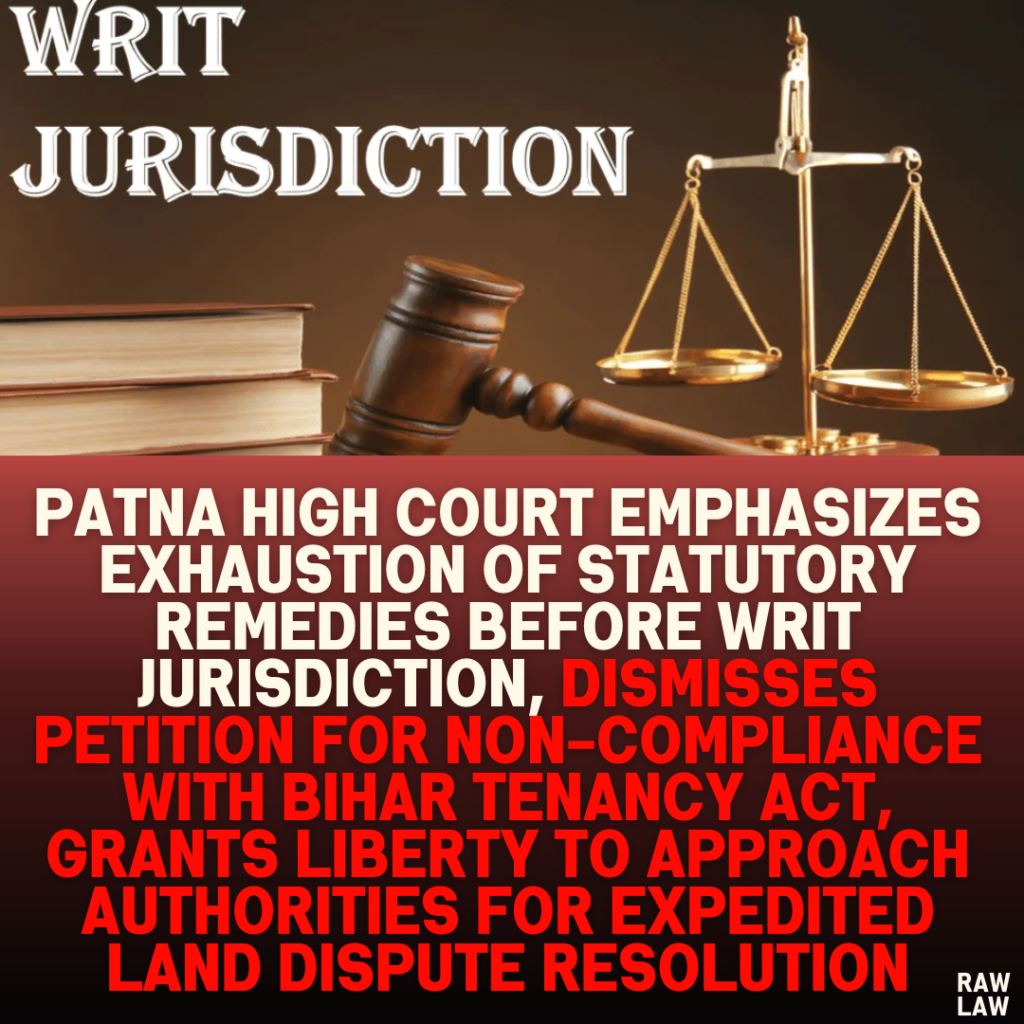Court’s Decision
The Patna High Court dismissed the writ petition, emphasizing that the petitioner had bypassed the available statutory remedies under the Bihar Tenancy Act, 1885. However, the court provided the petitioner with the liberty to approach the appropriate statutory authority within four weeks to seek redressal of the grievance. The court also directed the authority to dispose of the grievance expeditiously, considering the petitioner’s time spent in litigation sympathetically.
Facts of the Case
- Nature of the Dispute:
The petitioner claimed ownership and possession over land situated in Durgapur, Madhepura. The land details were: Khata Nos. 269 and 385, Khesra Nos. 324, 327, 328, 329, 332, 331, and 372, covering 3 bighas, 10 kathas, and 40 dhurs. - Dispute Origin:
Respondent No. 6 was declared a Bataidar of the disputed land by the Deputy Collector Land Reforms (DCLR), Udakishunganj, in an ex-parte order dated April 13, 1994, under Section 48(E) of the Bihar Tenancy Act. - Appeal Dismissal:
The petitioner challenged this order before the Additional Collector, but the appeal was dismissed, upholding the DCLR’s decision. - Current Petition:
The petitioner approached the High Court under writ jurisdiction to prevent public authorities and private respondents from interfering with their possession and title over the land and to set aside the decisions of the DCLR and the Additional Collector.
Issues
- Whether the petitioner had exhausted statutory remedies before approaching the High Court under writ jurisdiction.
- Whether the High Court could directly adjudicate upon the petitioner’s grievance in light of existing statutory mechanisms.
Petitioner’s Arguments
- Possession and Title:
The petitioner contended that they were the rightful owner and possessor of the disputed land. - Challenge to Bataidar Status:
The petitioner sought to invalidate the respondent’s claim as a Bataidar under the orders of the DCLR and the Additional Collector. - Relief Sought:
The petitioner sought a writ restraining public authorities and private respondents from interfering with their possession and the creation of Jamabandi (record of rights).
Respondent’s Arguments
- Failure to Exhaust Remedies:
The state argued that the petitioner had not availed the remedies provided under the Bihar Tenancy Act. - Non-Maintainability of Writ Petition:
The respondent submitted that the petitioner’s direct recourse to the High Court without approaching the appropriate statutory forum rendered the writ petition non-maintainable. - Appropriate Forum:
The state emphasized that statutory authorities, such as the Collector or the Board of Revenue, were better suited to resolve the grievance.
Analysis of the Law
- Principle of Exhaustion of Remedies:
The court highlighted the principle that a writ petition is ordinarily not maintainable if statutory remedies have not been exhausted. This principle ensures that alternative forums with specialized jurisdiction are utilized first. - Section 48(E) of Bihar Tenancy Act:
This section provides mechanisms for resolving disputes related to Bataidari claims. The Act allows for appeals and reviews within the statutory framework, which the petitioner had not fully utilized. - Writ Jurisdiction as Last Resort:
The court emphasized that writ jurisdiction under Article 226 of the Constitution is an extraordinary remedy that cannot bypass statutory processes unless special circumstances exist.
Precedent Analysis
The judgment is consistent with established principles laid down by courts, requiring litigants to exhaust statutory remedies before invoking writ jurisdiction. The court did not cite specific precedents but adhered to this long-standing judicial approach.
Court’s Reasoning
- Failure to Exhaust Remedies:
The court accepted the state’s argument that the petitioner had not exhausted the remedies under the Bihar Tenancy Act. - Liberty to Approach Statutory Authorities:
The court acknowledged the petitioner’s grievance and provided them with liberty to approach the appropriate statutory authority within four weeks to seek redressal. - Sympathetic Consideration:
The court directed the authority to consider the time spent in pursuing the writ petition while disposing of the grievance, ensuring that procedural delays did not prejudice the petitioner.
Conclusion
The writ petition was dismissed as non-maintainable. However, the court granted liberty to the petitioner to pursue statutory remedies within four weeks and directed the concerned authority to address the grievance expeditiously.
Implications
- Reinforcement of Legal Principle:
The judgment reaffirms that writ jurisdiction is not a substitute for statutory processes. - Guidance for Future Litigants:
The decision serves as a reminder to litigants to follow the procedural hierarchy before invoking the High Court’s writ jurisdiction. - Administrative Efficiency:
The court’s direction for expeditious disposal promotes timely resolution of disputes, reducing pendency.
